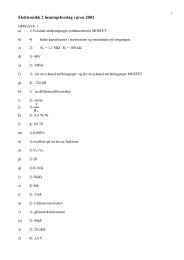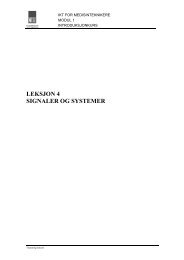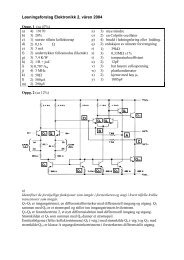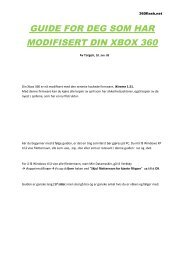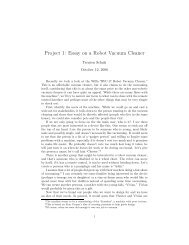The Online World resources handbook
The Online World resources handbook
The Online World resources handbook
You also want an ePaper? Increase the reach of your titles
YUMPU automatically turns print PDFs into web optimized ePapers that Google loves.
Electronic mail, telex, and fax http://home.eunet.no/~presno/bok/7.html<br />
like.<br />
Example: One of my addresses used to be presno@grida.no. By instructing my news reader<br />
to show it as presno@remove this bit for my real address, the information is made useless<br />
for spam software.<br />
Note: You are making it difficult for those you talk with when doing this. I wouldn't.<br />
You can also buy mail related utility programs, like MailJail, a mail filtering add on for<br />
the Eudora email programs. It's first release came with 250 rules to help thwart spam<br />
mail.<br />
Some users even join initiatives like the SPAM Filter, a free register of people who<br />
do not want to receive junk mail. It aims at using their list to filter their addresses against<br />
addresses collected by programs such as Floodgate (which automatically builds mailing<br />
lists from newsgroup ostings).<br />
Others report the incident to the spammer's Internet service provider (ISP). If you<br />
do, make sure to save the original email message with all headers intact. <strong>The</strong> email<br />
header is the part of the message that shows where the message originated. While your<br />
email program may not be set to display email headers, most programs let you do it.<br />
Generally, ISPs will not take action against one of their accounts without proof of the<br />
origination of the spam. <strong>The</strong>y often require the original spam message to be forwarded to<br />
them before they will take any action, with the email header included.<br />
<strong>The</strong>n, there is HTML email. <strong>The</strong>se permit inclusion of illustrations in messages,<br />
thus forcing a call to get them from a remote site when the mail is opened. When it does,<br />
the remote site will be able to record your email address, know if you have indeed<br />
opened (read?) the message, and your current IP address. <strong>The</strong> sender of the message<br />
may also be able to set a cookie in your browser, and thus identify you the next time you<br />
visit their site...<br />
<strong>The</strong> good news is that some email clients, like Eudora Pro, allows you to prevent it<br />
from automatically downloading HTML graphics. Recommended, and in particular if<br />
you're using modem.<br />
Finally, Whenever you subscribe to an email based mailing list, save the welcome<br />
message that the service returns on your disk. <strong>The</strong>se messages usually contain<br />
information about how to get off the list if the volume should become too high. You may<br />
find it easier to consult these files than try to get off by writing the mailing list<br />
administrators.<br />
<strong>The</strong>re's a FAQ on spam, a SPAM L mailing list, hints on reading email headers,<br />
and a tutorial for those in search for more.<br />
Purportal.com lets you search five of the most well known sites dedicated to<br />
setting the record straight: Snopes Urban Legends Archive, About.com Urban Legends,<br />
CIAC Hoax Database, CERT Computer Security Database, and Symantec (Real) Virus<br />
Encyclopedia. Last, but not least, there are a number of laws against spam.<br />
Managing your mailbox<br />
If you receive a large volumes of email, it becomes important to organize your mailbox<br />
to handle the most important mails first. Here are some hints:<br />
Consider using filters (message rules) to automatically move incoming mails to<br />
logical folders of your choice. For example, if you work in sales, you may move<br />
messages to folders called New opportunities, Follow up, Internal, and Private.<br />
<strong>The</strong>n, consider how much time should be allocated to handling the mail in each<br />
folder. Spam and mail from new persons will not be moved, and thus easier to<br />
handle. In MS Outlook, you may do this by clicking at Organize, or by selecting<br />
Tools | Message rules.<br />
Another trick is to give each mail from a known sender an automatic color code.<br />
For example, mark all mails from customers with red, those from members of your<br />
family with green, and mails from your boss with blue. Mails from new persons<br />
will have no color, and easier to single out for handling.<br />
If your email program can handle it, consider making copies of all received mail to<br />
an archive mailbox of your choice. Personally, I keep all important mail on my<br />
12 of 20 23.11.2009 15:45



